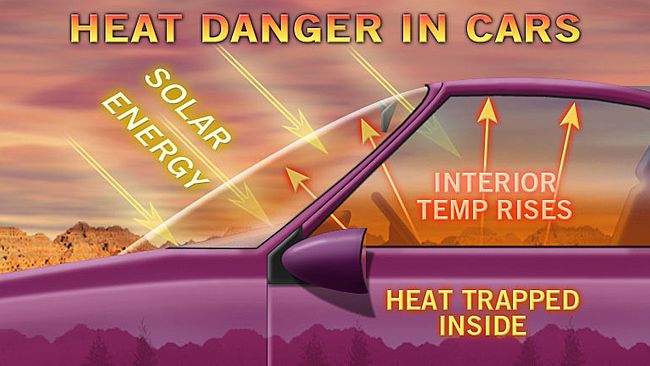Hot Cars Can Kill: 20 Children Already Dead in 2013

This article was provided by AccuWeather.com.
As a heat wave ripples across the country, hitting the I-95 corridor this week, temperatures will continue to soar. Accompanying the intense heat is an impending danger, as 20 children have died of heat stroke from being left in cars so far this year in the United States.
Last year 33 children died, according to Jan Null, CCM at San Francisco University.
"This is still 33 too many," Null said. Despite being four less than the yearly average of 37 children heatstroke deaths, according to Null's research, typically, 52 percent of these deaths are due to a caregiver forgetting a child in a car, and thus many could be prevented.
The heating dynamics of cars are much different than those of other forms of transportation. The windows of a car act as a catalysts for rapid temperature increases inside the vehicle.
"There are a lot of windows in cars. These windows let in a lot of sunlight and when that sunlight is absorbed, it becomes trapped inside the car," AccuWeather Meteorologist Michael Pigott said. "The temperature inside the car can become twice that of the temperature outside."
Most people believe that the color of the car is the biggest factor in determining which cars heat up most rapidly, but it is actually the color of the car's interior that is the determining factor. Cars with dark interior, such as black leather, heat up the quickest.
Get the world’s most fascinating discoveries delivered straight to your inbox.
Other parts of a car also aid in increasing the car's interior temperature, including the steering wheel and the dashboard. Due to their dark colors, steering wheels and dashboards can hit temperatures up to 200 degrees when sitting stationary in the sun. They then radiate their own heat and further heighten a car's temperature.
"When a child is left in a car, there is a 50/50 percent chance that they will be left on the sunny side of the car," Null said. This is especially dangerous because children, unlike adults, have not yet developed the ability to cool themselves off.
"Children heat up three to four times faster than adults," Null said.
RELATED: Summer's Worst Week of Heat NYC, DC, Philly, Boston Forecasted Heat Across the US Six Walking Tips for the Heat
Heat stroke, by clinical definition, occurs when the body reaches 104 degrees F. At 104, the body enters survival mode and stops perspiring. Only three degrees higher, at 107 degrees F, the body's cells start to die. This causes the internal organs to begin failing and death can occur soon after. These life-threatening temperatures can be reached quickly when one is stuck inside a car in the heat.
According to a study done by Null, recording the average temperature rise in a vehicle over time, a car's temperature can increase by 19 degrees in just 10 minutes. In one to two hours, the temperature inside a car can increase between 45 and 50 degrees.
"In the worst case scenario, if a child is small and on the sunny side of the car, death can occur in 15 minutes or under," Null said.
Pets, like children, have a lesser ability to cool themselves off compared to adult humans. Each year thousands of animals perish as a result of heat stroke when left in a vehicle. However, pets are better protected than children by today's legal system.
"There are more states with laws against leaving pets in the car than the 19 states with laws against leaving children in the car," Null said.
States with laws against leaving unattended children in cars include California, Connecticut, Florida, Hawaii, Illinois, Kentucky, Maryland, Michigan, Missouri, Nebraska, Nevada, Oklahoma, Pennsylvania, Rhode Island, Tennessee, Texas, Utah, Washington and Wisconsin.
Before exiting your vehicle, be sure to double check your backseat for some precious cargo you may be leaving behind. To help keep children safe, see the tips below from Null.
How to help keep children safe:
1. If you see a child unattended in a vehicle, immediately call 911.
2. Never leave a child unattended in a vehicle.
3. If you are missing a child, first check the pool and your vehicle.
4. Give yourself a visual reminder that your child is the backseat. Put the child's teddy bear on the front seat, put your cell phone, purse or briefcase in the backseat; that way you are forced to remember.
AccuWeather.com. All rights reserved. More from AccuWeather.com.


